Feb 26, 2020I have long believed that payment solutions tend to use fewer and fewer physical cards and more and more smartphones, and this is starting to become more evident now, even to less attentive eyes. It is not that I have a crystal ball or that I am some kind of prophet. The fact is, I have covered technologies for years, especially those related to doing business. Thus, I have seen that credit and debit payment cards have lost the favor of buyers and sellers and are rapidly falling behind. After all, smartphones are faster and more convenient to pay and receive money.
The other day, during a conversation with business executives, I mentioned this transformation in payment methods. One of them, a businessman in the footwear sector, interrupted to agree: "In China, for example, QR codes have been used for payments via cell phone for some years, without a debit or credit card."

And it's true! According to what I have learned, payments via QR codes in China were stimulated due to the great counterfeiting of paper money in that country. This encouraged traders and the government itself to adopt QR codes as a means of payment and as a way to fight organized crime. QR codes are one possible solution with encoded images that, through visible codes, allow buyers to pay for products only by focusing a smartphone's camera on the checkered design printed on a product's packaging, or on a scannable price and code label.
One alternative already available is digital printing, which has the advantage of using invisible codes. Thus, a product's packaging, without any apparent special code, can communicate with a smartphone camera in a natural way, as though it were the eyes of a person, capable of recognizing products just by looking at their packaging. What happens, in this case, is that the codes are embedded in the decorative image of the packaging, thereby creating personalized and individual identification without changing its layout in any way.
This solution allows you to gain information about a product that helps with logistics. More than that, though, it can favor differentiated experiences for a consumer, such as showing videos, user manuals, and information about product validity, recipe preparation, authenticity, manufacturing and warranties. It can also guide buyers regarding the correct disposal of packaging and the product itself.
In the case of coded chips, radio frequency identification (RFID), especially Near Field Communication (NFC) solutions, has been the main resource for payments. In this case, there is an added cost: that of the chip itself. The semiconductor will act as a tiny computer capable of storing data about the goods.
The use of smart tags becomes inevitable, especially when there is no way for systems to focus their cameras on one package—when several boxes are inside another larger box, for example. However, there is still no way to make a UHF RFID reading via smartphone, except for with NFC. The best way to ensure direct contact between a manufacturer and consumers has to be through QR codes or digital printing.

Almost always, one technology does not normally replace another. Technologies add up, and what matters, in the end, is the result for business. A technology's success will depend not only on its efficiency, but also on how much people like to use it and the benefits it brings.
Above all, the customer experience must be among the main aspects analyzed in packaging. Are identification and tracking important? Yes, because they impact costs and product quality. Is ensuring a product's authenticity important? Yes, it is, and this is also a matter of direct impact on a customer. Is the consumer experience important in purchasing, using and disposing of a product important? Yes, it is fundamental. What's more, it can add aspects that make packaging an interactive medium!
In short, talking about smart packaging or the Internet of Packaging (IoP) impacts not only the way of purchasing and paying for products, but the entire supply chain and the entire customer experience. The IoP provides sustainability for companies and still favors direct communication between manufacturers and consumers.
Edson Perin is the editor of IoP Journal Brasil and the founder of Netpress Editora.

